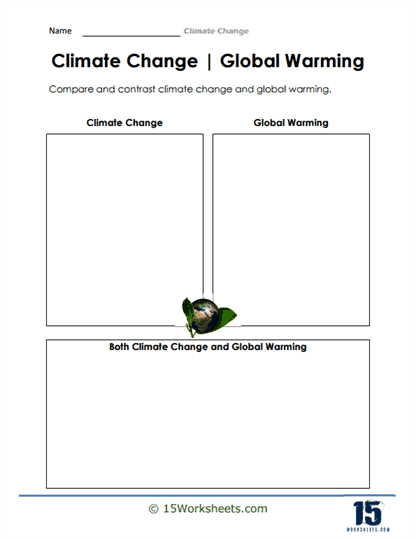Global Warming

Worksheet Description
Climate change and global warming are often used interchangeably, but they represent distinct yet related phenomena. Understanding the nuances between them is essential for comprehending their impacts on the environment. Compare and contrast climate change and global warming.
The worksheet aims to guide students in distinguishing between the concepts of climate change and global warming. Presented in a split format, it provides designated spaces for students to list characteristics of both phenomena, as well as a separate section to highlight their commonalities. The presence of an earth graphic in the center subtly emphasizes the gravity of the two topics in relation to our planet. The overarching objective is to ensure students understand the nuances between the terms, often used interchangeably, but which represent distinct aspects of the earth’s atmospheric changes.
To successfully engage with this worksheet, students should begin by brainstorming and listing down distinct attributes of climate change and global warming based on their prior knowledge. For climate change, they might address broad alterations in weather patterns over time, while global warming could focus on the specific rise in average global temperatures. After documenting these separate features, they should then consider overlaps in the two phenomena and record them in the “Both Climate Change and Global Warming” section. Utilizing reliable resources, like academic articles or approved textbooks, can assist students in ensuring their understanding and definitions are accurate and comprehensive.
This worksheet aims to foster a deeper comprehension of two pivotal environmental terms: climate change and global warming. By prompting students to compare and contrast, it encourages analytical thinking and discourages the oversimplification of these concepts. Educators seek to instill in students the ability to differentiate between the broad changes in climate versus the specific trend of increasing global temperatures. In essence, the exercise cultivates discernment and precision in students’ engagement with environmental science topics, equipping them for informed participation in related discussions and debates.
